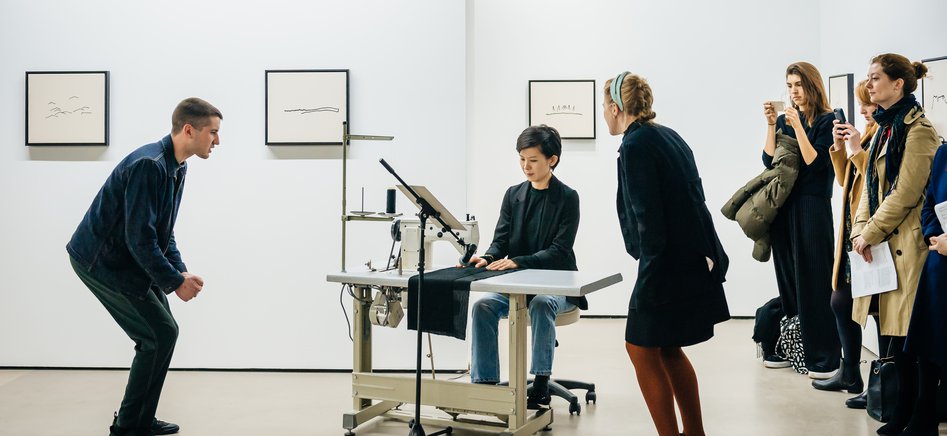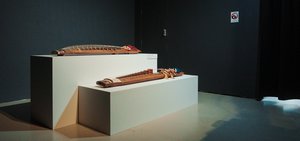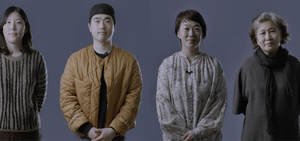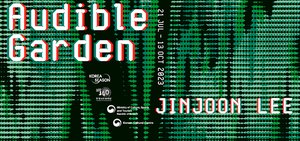Young In Hong: The Moon's Trick

The Moon’s Trick
The Korean Cultural Centre UK (KCCUK) is pleased to present the first solo exhibition at a public institution in the UK of Young In Hong (b.1972), on view from November 21st to December 30th, 2017. The exhibition focuses on a series of pieces made up of embroidered works, sound installation and performance. Embroidery, a signature working method of the artist, will be presented as a focal point of the exhibition from which a sound installation and performance will evolve.
Over the last decade, Hong’s large-scale embroidered works have been large not just in terms of their size and ambition, but also in terms of their labour-intensity. The images presented through the embroidery are often based on photos that Hong has found, images
that depict Korea’s recent history. When choosing photographs to work with, of particular interest to Hong is often the crowd found within specific political and cultural incidents. Through the medium of embroidery, Hong attempts to capture the transitional nature of a collective experience, associated with religious, cultural and political rituals.
Burning Love (2014), which evolved from a photo of a 2008 candle-lit demonstration in Seoul, is a good example of how Hong endeavours to re-visit these moments of time and place that she considers ‘compressed’ and therefore impossible to be decoded or represented as anything other than images. Often conceived of as a female affair, embroidery has long been perceived as an area specific to female labour. By using this predominantly female craft to reweave history, Hong’s work highlights the fleeting moments of shared experience and the immaterial forces behind them. Taking advantage of a medium that slows things down, for Hong, embroidery has proven to be a versatile artistic tool; each thread records the time that the artist has put into making the piece as well as the response to the artist’s desire to capture what the historical documents of the period may have missed.
Along with these existing pieces, Hong will bring together a new body of work that at first glance, looks less labour-intensive than her previous embroidered works, though the interest in the compressed expression of an image is just as strong. Prayers, No. 1-40 (2017), the abstract images of 40 pieces of embroidery in black and white, are derived from archive photos of post-war cityscapes
from the Korean peninsula, as well as the frequent protests and demonstrations which occurred during the subsequent modernization
period. Attracted to the power of images taken mainly by newspaper photographers at a time when freedom of speech was not guaranteed and censorship was commonplace, the artist pulls out certain forms from those photos and then pushes the outlines of
the images to the point that only abstract lines remain. It is from these remaining lines that Hong attempts to create musical scores. Thus, for Hong, these archive photos become what she calls ‘photo-scores’. During the exhibition, the music played and recorded by the artist herself based on these ‘photo-scores’ can be heard through the speakers installed in the gallery space.
Hong’s exploration of the relationship between image and sound via ‘photo-scores’ is further explored in the full-length ensemble piece Looking Down from the Sky (2017). This work is composed of 5 sections of intro, three developments and cadenza, written as a ‘photo-score’ embroidered on fabric, then stretched on five canvas frames. The sources of the score are archive photos of protests and demonstrations that took place between the 1960s and 1990s in South Korea. These canvases will function as a musical score for the live performance, which will be premiered on the opening night of the exhibition. The particular shapes of the score represent specific durations, pitch and sound-effects that could be appropriated by the performers; the artist invites other musicians to participate by asking them to recreate their own music based on her photo-score so that her musical work can be translated into something that is not solely within her own control.
This constant process of translation unfolds in the exhibition space and in so doing creates intensities and layers within the work, where meanings are repeatedly translated from one form to another. For this reason, the artist has named her exhibition The Moon’s Trick, which is taken from one of Soo-Young Kim’s (1921-1968) early poems. In this poem, the main image is a spinning top which Kim once observed. The poet was amazed by the vortex created by the spinning top. When watching it, he felt that it allowed him to exist in a different sphere of the world. The poet named this moment ‘the moon’s trick’.
Under this title, the artist expresses her longing to trigger moments where a kind of absorption takes place, in the same way that
poet Kim was amazed by the spinning top that almost took him to a different level of perception. The artist attempts to achieve this through a constant process of translation moving towards a state where the original point of departure is blurred and the conventional notion of authorship is integrated. In this process of translation, what is emphasised most of all is the specific mode of ‘doings’ through which each stage of translation is activated by the artist as well as the participants of the exhibition.
The intensity of labour and the experience of absorption, whether being part of a crowd or a cadenza are the ways by which Hong chooses to express a notion of modernity. And this modernity for Hong, in which Korea has played its own part, is an on-going global event that continues to transform lives.
Young In Hong’s work embraces performance, textiles, installation and collaboration, all important elements of her practice. Hong’s work has been shown at international venues including Block Universe (2017), Grand Palais, Paris (2016), ICA London (2015), Gwangju Biennale (2014) and Plateau Museum, Seoul (2014). Young In Hong completed her BA Sculpture at Seoul National University (1996) and has an MA and PhD in Fine Art from Goldsmiths College (2000, 2012). Hong presently lives and works in Bristol, and is a senior lecturer at Bath School of Art and Design, Bath Spa University.
For more photos, click here: More photos





